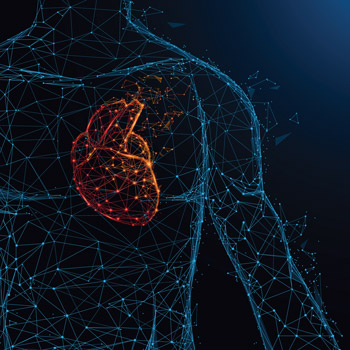Combat cardiac risks of cancer therapies
One challenge of treating cancer is preventing, diagnosing, and treating heart failure in at-risk patients, and figuring out which patients would benefit from intervention.
As if surviving cancer weren't enough, many oncology patients are then faced with another problem—heart failure.
“All of our patients receiving potentially cardiotoxic cancer therapy should be considered to be in stage A heart failure,” said Dinesh Thavendiranathan, MD, at the annual meeting of the American Society of Clinical Oncology (ASCO), held in Chicago in June.

Dr. Thavendiranathan, a cardiologist and associate professor at the University of Toronto, offered advice on preventing, diagnosing, and treating heart failure in at-risk patients, particularly those with breast cancer treated by anthracyclines or trastuzumab.
He has seen the importance of this issue firsthand, for example, in a 51-year-old woman with breast cancer who was referred to his cardio-oncology clinic for assessment. After anthracycline therapy, she had reduced ejection fraction and an increased troponin level.
“Because of lack of good evidence to intervene at this time, we elected to just follow her, but unfortunately she returned back about a month later with stage C heart failure and a further reduction in ejection fraction,” said Dr. Thavendiranathan. The patient received aggressive medical treatment at that point, but two years later, her cardiac function is still reduced.
“I can't help asking the question, if I [had] intervened [sooner], could I have prevented the development of clinical heart failure and subsequent persistently reduced ejection fraction?” he said.
The challenge is figuring out which patients would benefit from intervention (and which intervention). Although all patients on anthracyclines or trastuzumab therapy have stage A or “pre-heart failure” according to the American College of Cardiology and the American Heart Association, more risk stratification is needed before taking action.
In other words, “Can we identify a high-risk subgroup on whom we can focus on preventive strategies?” asked Dr. Thavendiranathan. In part, a cancer patient's risk for cardiotoxicity is determined by the usual factors familiar to internists: older age, diabetes, hypertension, and existing cardiovascular diseases, such as atrial fibrillation or coronary artery disease.
These conditions should all be optimally treated, of course. “We focus on aggressively managing their cardiovascular risk factors before the initiation of any potentially cardiotoxic cancer therapies,” Dr. Thavendiranathan said.
Another predictor of cardiac risk from cancer treatment is ejection fraction. “We know that in anthracycline-treated patients, patients who have below-normal or mildly reduced ejection fraction at the initiation of cancer therapy are subsequently at significantly higher risk of symptomatic heart failure and cardiac death,” he said. The same is true for trastuzumab, and both drugs are specifically mentioned as risk factors in ASCO's 2017 guideline “Prevention and Monitoring of Cardiac Dysfunction in Survivors of Adult Cancers,” Dr. Thavendiranathan noted.
Thus, it's important to identify the patients whose ejection fraction puts them at risk from the start. “If we need to measure ejection fraction, we need a method that measures ejection fraction accurately,” he said. “There's been a move towards using echocardiography as the preferred method to monitor patients during cancer therapies.”
In particular, three-dimensional echocardiography is catching on, he added: “3-D techniques are more accurate and are more precise in measurement of ejection fraction.” Research specifically in cancer patients has shown 3-D echocardiography to outperform cardiac MRI and 2-D echo, Dr. Thavendiranathan reported.
That's not the only hot new method of evaluating the heart, though. “There's been a move towards considering myocardial strain imaging, which looks beyond just a translation of the borders of the heart to measure myocardial deformation. It has been suggested this may be a better marker of myocardial contractility than ejection fraction,” he said.
Myocardial strain imaging provides a measurement of global longitudinal strain, which is a comparison of the length of a segment of the myocardium in its relaxed state and its contracted state. “The formula that's used is the contracted state minus the relaxed state, divided by the relaxed state length. Since the relaxed state is longer, based on this formula, global longitudinal strain is measured as a negative number,” said Dr. Thavendiranathan.
Don't be intimidated by those calculations, he urged. “When there's a new technique that's introduced, there's always a bit of trepidation about using this technique, and I want to reassure you that strain measurements are not really more complex than ejection fraction measurements.”
The negative sign is typically removed from global longitudinal strain measurements, and 19 is the cutoff for a normal result. “So you can really think of any value less than 19 being abnormal, and any value more than 19 being normal,” he said.
Myocardial strain imaging seems to be effective for identifying abnormal cardiac function before cancer treatment is initiated as well as declines during and after treatment, he reported.
In addition to imaging, biomarkers might be useful to predict or diagnose cardiotoxicity. Thus far, though, baseline measurements have not shown a correlation with outcomes. “It appears that no specific protein biomarker seemed to identify patients at elevated risk for heart failure, but there's probably still value to protein markers,” said Dr. Thavendiranathan, citing a study published in the Journal of the American College of Cardiology in March 2014.
Specifically, the study found that although baseline results weren't predictive, two biomarkers could be early indicators of cardiac problems developing during cancer therapy. “A change in high-sensitivity troponin as well as myeloperoxidase seemed to identify patients at elevated risk of subsequent heart failure,” he said.
There are still uncertainties about how to apply these research findings to clinical practice. “We don't know exactly when to measure these biomarkers. We're not sure what specific assay to use, and we don't have thresholds for abnormality that have been defined,” Dr. Thavendiranathan said.
He noted that there is another, even bigger, question to ask once early markers of cardiotoxicity have been identified: “So, can we change the outcomes of these patients?”
Currently, interventions seem to be coming too late for most patients, he said, citing a study published in Circulation in 2015. “Once we identified cardiotoxicity and we initiated state-of-the-art heart failure therapy, nine out of 10 patients will not have complete recovery of their ejection fraction,” he said. The patients whose ejection fraction didn't recover were also at higher risk of major adverse cardiovascular events.
There is promise, however, that the newer methods of identifying at-risk patients will provide more effective solutions. “There have been some small studies that have suggested if we do intervene with beta-blockers when there's a significant fall in global longitudinal strain, we can prevent the progression of heart failure and promote recovery of myocardial function,” Dr. Thavendiranathan said.
Angiotensin-converting enzyme (ACE) inhibitors may also help, since one study showed that they could reduce cancer patients' risk of progression to heart failure when prescribed as soon as an elevated troponin level was observed.
A trial is currently underway to test these concepts. “We are randomizing patients at elevated risk of heart failure to a strain-based follow-up or an ejection fraction-based follow-up and, when there's a significant fall in strain, we initiate beta-blockers and ACE inhibitors, with the hope ultimately that by three years of follow-up, we can prevent heart failure and we can prevent interruption of cancer therapy as well,” said Dr. Thavendiranathan.
Researchers are also investigating the potential of other drugs to prevent cardiotoxicities of cancer drugs. “The largest body of literature is on dexrazoxane, angiotensin antagonists, beta-blockers, and statins. For heart failure, the only drugs that showed significant benefit were dexrazoxane as well as angiotensin antagonists,” he said, citing a study published in the March 1, 2017, Annals of Oncology.
Despite these findings, current trials are experimenting with statins, among other potential preventive measures against cardiotoxicity, he noted. “There's a lot of excitement in the oncology area and a lot of work that's being done to see if we can change outcomes in these patients,” he said. “In the next five or 10 years, when we see these studies being published … these studies I believe will change the way we follow patients during cancer therapy.”





